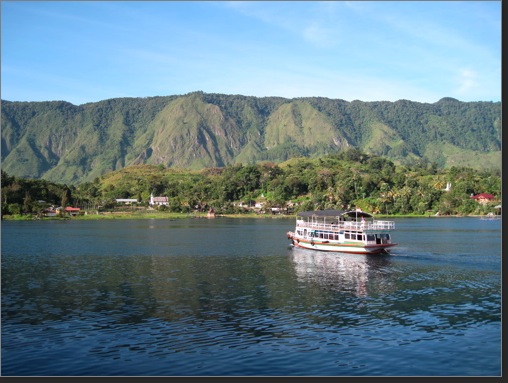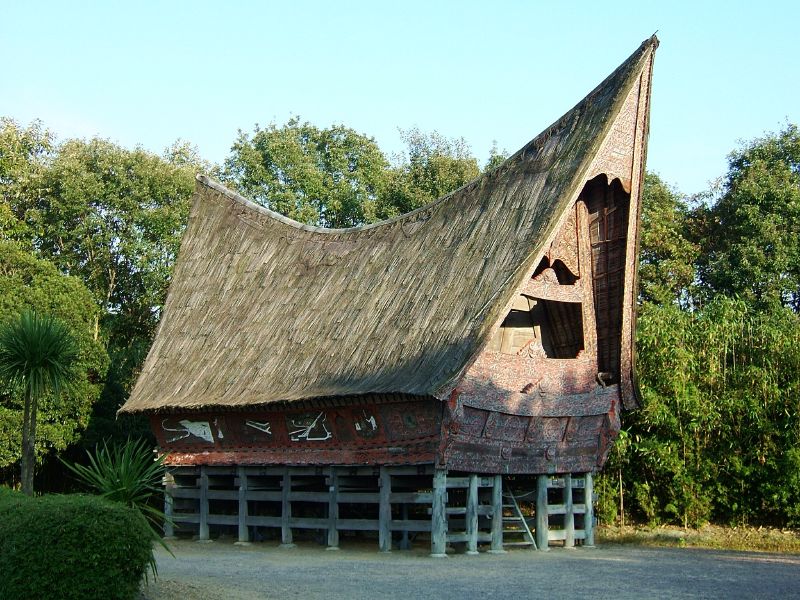The Beautiful Scenery and Distinctive Culture of Samosir

 |
| From Medan to Berastagi to Lake Toba |
 |
| View of Lake Toba from Samosir Island |
Actually Samosir used to be more of a tourist attraction, as did the rest of Sumatra. Backpackers even set up a Koh Phagnan style Full Moon party on Samosir. Nowadays it receives a fraction of the international tourists. Many people I met on the Banana Pancake Trail, a name for the typical backpacker stops in SE Asia, were only stopping in Bali and the surrounding islands when going to Indonesia. Toba is still more touristy than other parts of Sumatra, but it was nice not to have huge crowds like some of the islands in Thailand.
The story of Lake Toba is fascinating (at least to me). Some 77,000 years ago a super volcano erupted with such force that it created the island Samosir with a surrounding crater, which became Lake Toba. The lake is 100 kilometers long by 30 kilometers wide and over 500 meters deep (nearly 1,700 feet)! The eruption that created the beautiful Lake and island was the largest on Earth in the last 25 million years. A cloud of ash covered much of SE Asia and beyond; studies near Lake Malawi in East Africa uncovered large ash deposits from Toba!
The massive erruption led to a global winter, with temperatures dropping from 3 to 5 °C (5 to 9 °F) up to 15 °C (27 °F) at higher altitudes! A theory posits that the effects of Toba created a volcanic winter lasting up to 10 years. This major climate event could have caused a bottleneck in human evolution, whereby the population shrunk to only a few thousand reproducing individuals, thus limiting our modern genetic diversity. The theory hasn't been accepted by many scientists, however, because there is no evidence of widespread decline or extinction of other animals. Even if the theory proves incorrect it still makes for an interesting read http://en.wikipedia.org/wiki/Toba_catastrophe_theory
Although Berastagi is also a tourist stop between Medan and Toba, there was no direct connection to the lake. Well I could have taken a direct tourist bus which was more expensive and may or may not have been in service, depending on how many people purchased tickets. Instead I took the adventurous option. I had to take a pickup truck to Kabanjahe, transfer to a small bus, then transfer once more before arriving in Parapat, the town with a ferry service to Samosir.
The views of Samosir from the road approaching Parapat and the ferry were breathtaking. I don't know if I've seen anything like it. Pictures will do the scenery more justice than I can:
 |
| Lake Toba |
 |
| The ferry to Samosir |
The ferry unloaded in the small town of Tuk Tuk, a penninsula jutting out from the main island. As most of the tourist facilities were located in Tuk Tuk I settled in on a guesthouse nearby. I booked what was probably the smallest single room I've stayed in yet, but for a place to myself (and a shared bathroom) it was only 50,000 Rupiah, or 5 dollars. Sounds a lot cheaper when I quote the price in dollars! The price was typically only 3 bucks, but since August is high season I had to pay the busy rate. Budget traveling in SE Asia is great!
That evening I took a walk around town and grabbed dinner at one of the only local looking places - most were tourist restaurants - and then called it an early night. I tried to update my blog, something I hadn't done in a long time!
 |
| My guesthouse in Tuk Tuk |
 |
| Tuk Tuk, a small town jutting out from Samosir island |
While on the walk that evening I had negotiated a price for renting out a motorbike the following day. Considering the last time I had driven a bike was in the Central Highlands of Vietnam, where I tore up my leg, I was hesitant. But the roads were pretty quiet and there really wasn't much else to do without access to transportation. So the next morning I picked up my motorbike and took it out for a joy ride!
I first drove the coastal road around the northern portion of the island to Pangururan, the largest town on the island. Before reaching town I tried to cut inland to check out the scenery and roads less traveled. The roads weren't marked though, and the paved surface soon turned into dirt, then simply rocks. The ride wasn't so kind on my behind! By the time I got through the rocky bit all that was left of the road was a small dirt path. I saw a few kids outside of their house, the first house I had seen in awhile. When I said hello they ran inside and shut the door! I'm guessing they hadn't seen many tourists on that route. Eventually it seemed I was just driving on someone's private path, so I cut my losses and headed back to the coastal road.
The natural scenery on the dive was beautiful, with the deep blue lake in the foreground surrounded by steep cliffs. But even more unique was the local architecture. The Batak people who inhabit the area are known for their boat-shaped houses and community centers. Most Batak are Christian, but they incorporate ancient traditions into their faith. Graves are constructed to resemble miniature versions of their houses as it is believed the spirits of dead relatives continue to reside there.
 |
| A traditional Batak house |
 |
| Batak graves dot the island |
 |
| Another grave site |
I had been planning to withdraw money from an ATM but could find none in Tuk Tuk (and good luck trying to use a credit card!). Upon spotting a bank in Pangururan I was relieved to know I could get cash. The sense of relief soon turned into concern when the machine said it wouldn't accept my card. Luckily I found another bank in town, but again my hopes were dashed when I came up empty.
It turns out none of the ATMs on the island accepted foreign cards - I had to wait and withdraw money from a specific ATM on the mainland town of Parapat the next day. I must have had less than 20 dollars on me, but it was just enough to last through the next morning.
 |
| Market in Pangururan |
 |
| 100,000 Rupiah, less than 10 USD |
From Pangururan I drove to the interior of the island. This time the road actually continued - although it still wasn't in great shape. From the coast to the center of Samosir the elevation change is substantial. It felt like more than the elevation had changed too. The coast is heavily populated, whereas the interior has few people. I saw several tourists driving in the lowlands, but none up in the hills. I wasn't sure which way to go but asking for directions was an easy way to chat up a few locals.
As I slowly made my way back toward Tuk Tuk rain seemed close. The road condition worsened and what was partially paved again became no more than an assortment of rocks protruding from the ground. Judging from my rudimentary map I determined I must be in the area marked "forest," as there were no signs of villages or people.
Just as I was making out of the forest drops began to fall, and quickly it turned into a downpour. I could see Lake Toba and the town of Tuk Tuk below, but stopped to wait on the rain. My destination my have been in sight, but it still took me a good 20 minutes to weave down the mountain, thankfully on a newly paved road. Once at lake-level I grabbed dinner at a small restaurant and didn't get back to Tuk Tuk until it was pitch black.
 |
| Tuk Tuk peninsula |
I had planned to leave the next day, but transport was an issue. I happened to be visiting in the middle of a post-Ramadan national holiday where millions of Indonesians travel to their home towns. Roads are clogged, buses full, and hotels more expensive. I tired to book a ticket once in Parapat but even the bus station was closed! By chance I found a local - the owner of the restaurant where I ate - who made a few calls and hooked me up with a ride. Appartently people will use their own vehicles to transport travelers during the busy holidays. And he was making good money - I had to pay about 30 dollars for the trip! But considering it was either stay for three more days in Tuk Tuk to wait for a public bus or cough up the cash, I chose the latter option.


Comments